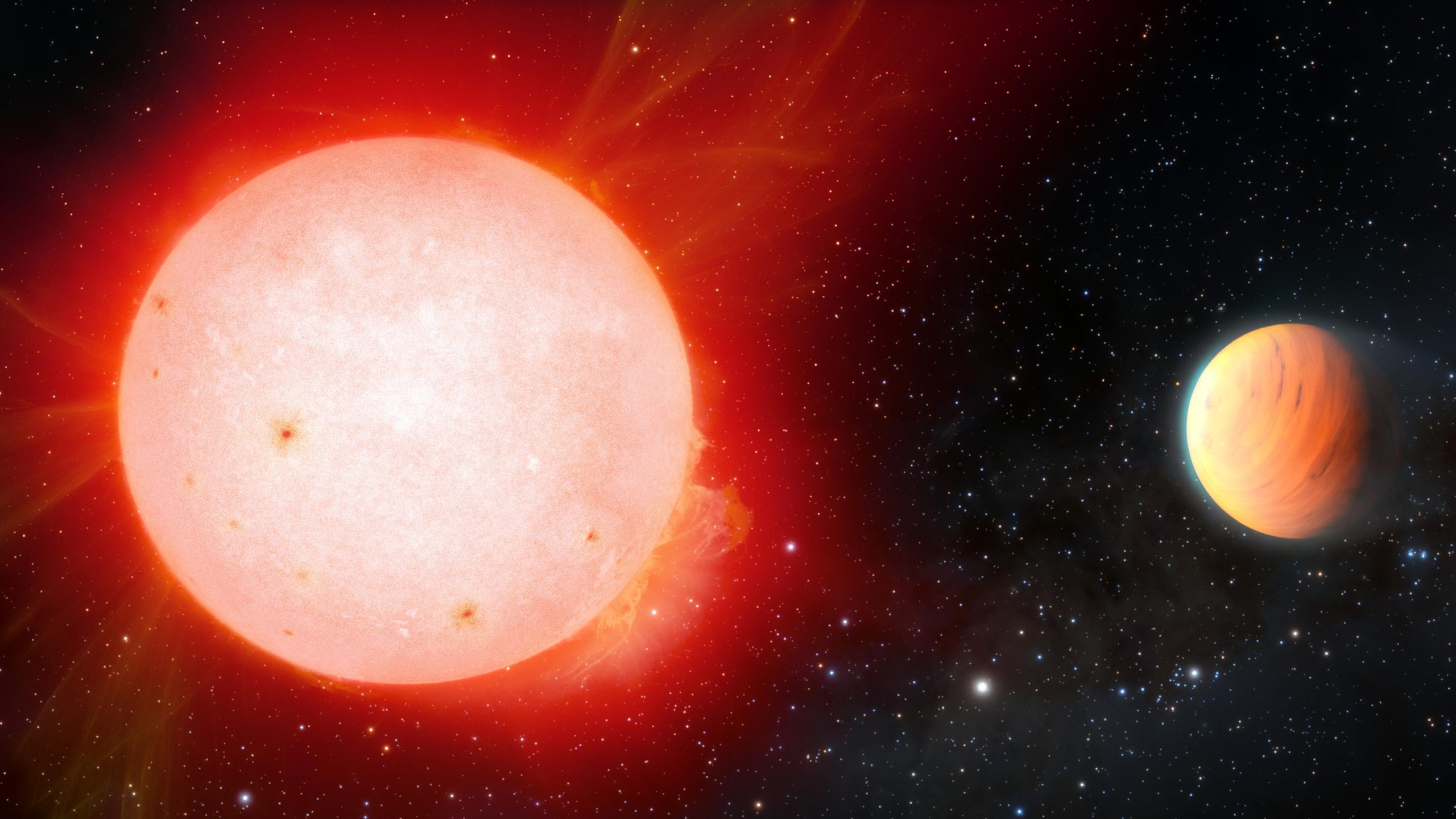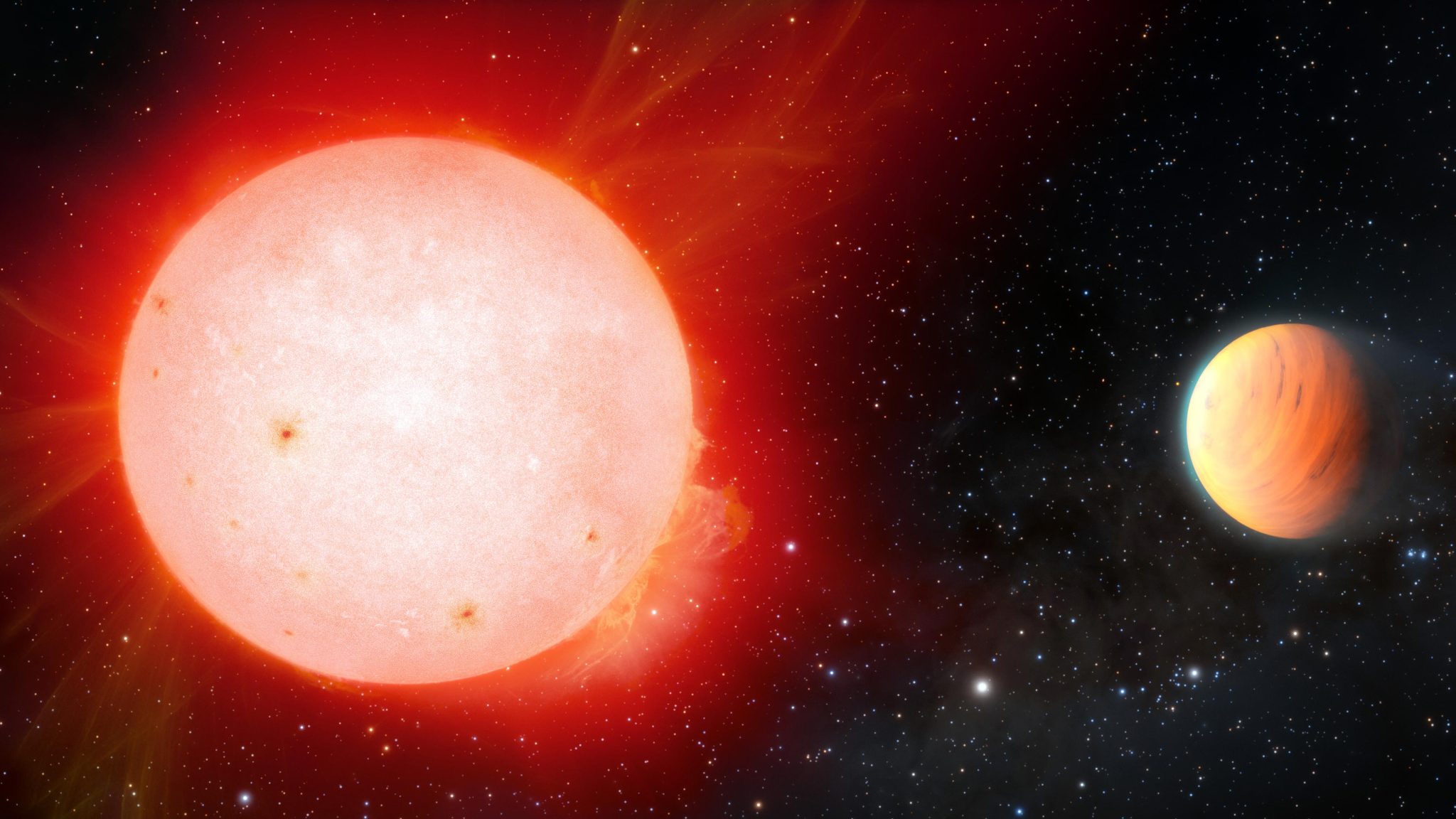

Impresie artistică a unei planete gigantice gazoase foarte subțiri care orbitează o stea pitică roșie. Planetă exterioară gigantică gazoasă [right] Densitatea marshmallows detectată pe orbită în jurul unei stele pitice roșii reci [left] de Instrumentul de viteză radială NEID, finanțat de NASA, pe telescopul WIYN de 3,5 metri de la Observatorul Național Kitt Peak, un program al NSF NOIRLab. Planeta, numită TOI-3757 b, este cea mai subțire planetă gigantică gazoasă descoperită vreodată în jurul acestui tip de stele. Credit: NOIRLab/NSF/AURA/J. da Silva/Spaceengine/M. Zamani
Telescopul Kitt Peak al Observatorului Național ajută la determinarea acestui lucru[{” attribute=””>Jupiter-like Planet is the lowest-density gas giant ever detected around a red dwarf.
A gas giant exoplanet with the density of a marshmallow has been detected in orbit around a cool red dwarf star. A suite of astronomical instruments was used to make the observations, including the NASA-funded NEID radial-velocity instrument on the WIYN 3.5-meter Telescope at Kitt Peak National Observatory, a Program of NSF’s NOIRLab. Named TOI-3757 b, the exoplanet is the fluffiest gas giant planet ever discovered around this type of star.
Using the WIYN 3.5-meter Telescope at Kitt Peak National Observatory in Arizona, astronomers have observed an unusual Jupiter-like planet in orbit around a cool red dwarf star. Located in the constellation of Auriga the Charioteer around 580 light-years from Earth, this planet, identified as TOI-3757 b, is the lowest-density planet ever detected around a red dwarf star and is estimated to have an average density akin to that of a marshmallow.
Red dwarf stars are the smallest and dimmest members of so-called main-sequence stars — stars that convert hydrogen into helium in their cores at a steady rate. Although they are “cool” compared to stars like our Sun, red dwarf stars can be extremely active and erupt with powerful flares. This can strip orbiting planets of their atmospheres, making this star system a seemingly inhospitable location to form such a gossamer planet.
Shubham Kanodia, cercetător la Carnegie Institution for Science’s Earth and Planetary Laboratory și primul autor al unei lucrări publicate în Jurnal astrologicla. Până acum acest lucru a fost observat doar de eșantioane mici de sondaje Doppler, care au găsit de obicei planete gigantice departe de aceste stele pitice roșii. Până acum nu am avut un eșantion suficient de mare de planete pentru a găsi planete gazoase din apropiere într-un mod robust.”
Există încă mistere neexplicate în jurul TOI-3757 b, principalul dintre ele cum s-ar putea forma o planetă gigantică gazoasă în jurul unei stele pitice roșii, în special a unei planete cu densitate mică. Cu toate acestea, echipa Kanodia crede că ar putea avea o soluție la acest mister.

Din terenul Observatorului Național Kit Peak (KPNO), un program al NSF NOIRLab, telescopul Wisconsin-Indiana-Yale-NOIRLab (WIYN) de 3,5 metri pare să observă Calea Lactee în timp ce se revarsă de la orizont. Strălucirea atmosferică roșiatică, un fenomen natural, colorează și orizontul. KPNO este situat în deșertul Arizona Sonoran din Națiunea Tohono O’odham și această vedere clară a unei părți a planului Căii Lactee arată condițiile favorabile din acest mediu necesare pentru a vedea corpurile cerești slabe. Aceste condiții, care includ niveluri scăzute de poluare luminoasă, cer cu 20° mai întunecat și condiții atmosferice uscate, au permis cercetătorilor de la consorțiul WIYN să urmărească observațiile galaxiilor, nebuloaselor și exoplanetelor, precum și ale multor alte ținte astronomice folosind WIYN de 3,5 metri. telescopul și sora sa, telescopul WIYN de 0,9 metri. Credit: KPNO/NOIRLab/NSF/AURA/R. Sparks
Ei sugerează că densitatea extrem de scăzută a TOI-3757 b ar putea fi rezultatul a doi factori. Primul se referă la miezul stâncos al planetei; Se crede că giganții gazosi încep ca nuclee stâncoase masive cu o masă de aproximativ zece ori mai mare decât masa Pământului, moment în care atrag rapid cantități mari de gaz din apropiere pentru a forma giganții gazosi pe care îi vedem astăzi. TOI-3757b are o abundență mai mică de elemente grele decât alți pitici M cu giganți gazosi, iar acest lucru ar fi putut duce la formarea nucleului stâncos mai lent, întârziind debutul acumulării de gaze și afectând astfel densitatea globală a planetei.
Un al doilea factor poate fi orbita planetei, despre care se crede că este ușor eliptică. Există momente în care se apropie mai mult de steaua sa decât alte ori, rezultând o încălzire în exces semnificativă care poate determina umflarea atmosferei planetei.
Satelitul în tranzit al NASA pentru sondajul exoplanetelor ([{” attribute=””>TESS) initially spotted the planet. Kanodia’s team then made follow-up observations using ground-based instruments, including NEID and NESSI (NN-EXPLORE Exoplanet Stellar Speckle Imager), both housed at the WIYN 3.5-meter Telescope; the Habitable-zone Planet Finder (HPF) on the Hobby-Eberly Telescope; and the Red Buttes Observatory (RBO) in Wyoming.
TESS surveyed the crossing of this planet TOI-3757 b in front of its star, which allowed astronomers to calculate the planet’s diameter to be about 150,000 kilometers (100,000 miles) or about just slightly larger than that of Jupiter. The planet finishes one complete orbit around its host star in just 3.5 days, 25 times less than the closest planet in our Solar System — Mercury — which takes about 88 days to do so.
The astronomers then used NEID and HPF to measure the star’s apparent motion along the line of sight, also known as its radial velocity. These measurements provided the planet’s mass, which was calculated to be about one-quarter that of Jupiter, or about 85 times the mass of the Earth. Knowing the size and the mass allowed Kanodia’s team to calculate TOI-3757 b’s average density as being 0.27 grams per cubic centimeter (about 17 grams per cubic feet), which would make it less than half the density of Saturn (the lowest-density planet in the Solar System), about one quarter the density of water (meaning it would float if placed in a giant bathtub filled with water), or in fact, similar in density to a marshmallow.
“Potential future observations of the atmosphere of this planet using NASA’s new James Webb Space Telescope could help shed light on its puffy nature,” says Jessica Libby-Roberts, a postdoctoral researcher at Pennsylvania State University and the second author on this paper.
“Finding more such systems with giant planets — which were once theorized to be extremely rare around red dwarfs — is part of our goal to understand how planets form,” says Kanodia.
The discovery highlights the importance of NEID in its ability to confirm some of the candidate exoplanets currently being discovered by NASA’s TESS mission, providing important targets for the new James Webb Space Telescope (JWST) to follow up on and begin characterizing their atmospheres. This will in turn inform astronomers what the planets are made of and how they formed and, for potentially habitable rocky worlds, whether they might be able to support life.
Reference: “TOI-3757 b: A low-density gas giant orbiting a solar-metallicity M dwarf” by Shubham Kanodia, Jessica Libby-Roberts, Caleb I. Cañas, Joe P. Ninan, Suvrath Mahadevan, Gudmundur Stefansson, Andrea S. J. Lin, Sinclaire Jones, Andrew Monson, Brock A. Parker, Henry A. Kobulnicky, Tera N. Swaby, Luke Powers, Corey Beard, Chad F. Bender, Cullen H. Blake, William D. Cochran, Jiayin Dong, Scott A. Diddams, Connor Fredrick, Arvind F. Gupta, Samuel Halverson, Fred Hearty, Sarah E. Logsdon, Andrew J. Metcalf, Michael W. McElwain, Caroline Morley, Jayadev Rajagopal, Lawrence W. Ramsey, Paul Robertson, Arpita Roy, Christian Schwab, Ryan C. Terrien, John Wisniewski and Jason T. Wright, 5 August 2022, The Astronomical Journal.
DOI: 10.3847/1538-3881/ac7c20

„Mândru pasionat al rețelelor sociale. Savant web fără scuze. Guru al internetului. Pasionat de muzică de-o viață. Specialist în călătorii.”





More Stories
Simulările pe supercomputer dezvăluie natura turbulenței în discurile de acumulare a găurilor negre
Trăiește cu anxietate: sfaturi de specialitate despre cum să accepti o afecțiune de sănătate mintală
Noile cercetări asupra unei falii masive de tracțiune sugerează că următorul cutremur mare ar putea fi iminent